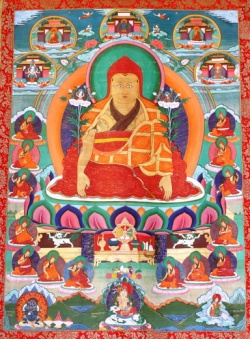Difference between revisions of "Dolpopa's view of Emptiness"
(Created page with "thumb|250px| <poem> "I bow at the feet of the masters who carefully distinguish, 'All imagined and dependent phenomena are nonexistent, ...") |
|||
| Line 1: | Line 1: | ||
[[File:Dolpopa Sherab Gyaltsen 1.jpg|thumb|250px|]] | [[File:Dolpopa Sherab Gyaltsen 1.jpg|thumb|250px|]] | ||
<poem> | <poem> | ||
| − | "I bow at the feet of the masters | + | "I bow at the feet of the [[masters]] |
| − | who carefully distinguish, 'All imagined | + | who carefully distinguish, 'All [[imagined]] |
| − | and dependent phenomena are nonexistent, | + | and dependent [[phenomena]] are nonexistent, |
| − | but the fully established true nature | + | but the fully established [[true nature]] |
is never nonexistent,' | is never nonexistent,' | ||
| − | teaching what transcends existence | + | [[teaching]] what transcends [[existence]] |
| − | and nonexistence, and eternalism and nihilism." | + | and nonexistence, and [[eternalism]] and [[nihilism]]." |
| − | Dolpopa, General Commentary on the Doctrine | + | [[Dolpopa]], General Commentary on the [[Doctrine]] |
| − | Dolpopa Sherab Gyaltsen, a 14th century Tibetan Master, most known for his development of the shentong (empty of other) view, to describe the absolute reality as empty of other relative phenomena, but not itself empty. Though many before him in India and Tibet held this view, Dolpopa was the first to write this teaching with new language that was quite shocking for his contemporaries. He held that the two truths, the relative and ultimate or absolute were both empty (as posited in all Buddhist teachings) yet empty in two quite different ways. Relative phenomena are empty of independent existence or self-nature, and ultimate reality is empty only of other relative phenomena. Therefore, Dolpopa posited that the ultimate reality was self-luminous, unchanging, unbounded and empty. | + | [[Dolpopa Sherab Gyaltsen]], a 14th century [[Tibetan]] [[Master]], most known for his development of the [[shentong]] ([[empty]] of other) [[view]], to describe the [[absolute reality]] as [[empty]] of other [[relative]] [[phenomena]], but not itself [[empty]]. Though many before him in [[India]] and [[Tibet]] held this [[view]], [[Dolpopa]] was the first to write this [[teaching]] with new [[language]] that was quite shocking for his contemporaries. He held that the [[two truths]], the [[relative]] and [[ultimate]] or [[absolute]] were both [[empty]] (as posited in all [[Buddhist teachings]]) yet [[empty]] in two quite different ways. [[Relative]] [[phenomena]] are [[empty]] of independent [[existence]] or [[self-nature]], and [[ultimate reality]] is [[empty]] only of other [[relative]] [[phenomena]]. Therefore, [[Dolpopa]] posited that the [[ultimate reality]] was self-luminous, [[unchanging]], unbounded and [[empty]]. |
</poem> | </poem> | ||
{{R}} | {{R}} | ||
Revision as of 21:50, 2 September 2013
"I bow at the feet of the masters
who carefully distinguish, 'All imagined
and dependent phenomena are nonexistent,
but the fully established true nature
is never nonexistent,'
teaching what transcends existence
and nonexistence, and eternalism and nihilism."
Dolpopa, General Commentary on the Doctrine
Dolpopa Sherab Gyaltsen, a 14th century Tibetan Master, most known for his development of the shentong (empty of other) view, to describe the absolute reality as empty of other relative phenomena, but not itself empty. Though many before him in India and Tibet held this view, Dolpopa was the first to write this teaching with new language that was quite shocking for his contemporaries. He held that the two truths, the relative and ultimate or absolute were both empty (as posited in all Buddhist teachings) yet empty in two quite different ways. Relative phenomena are empty of independent existence or self-nature, and ultimate reality is empty only of other relative phenomena. Therefore, Dolpopa posited that the ultimate reality was self-luminous, unchanging, unbounded and empty.
